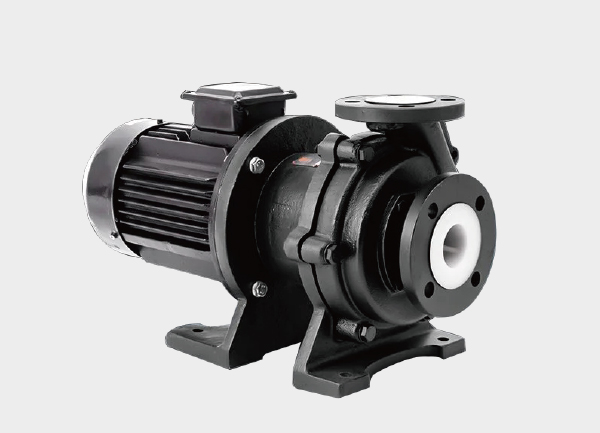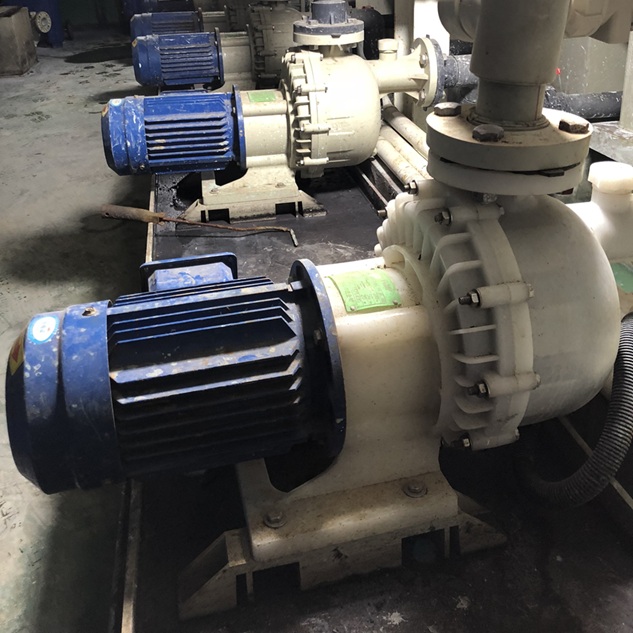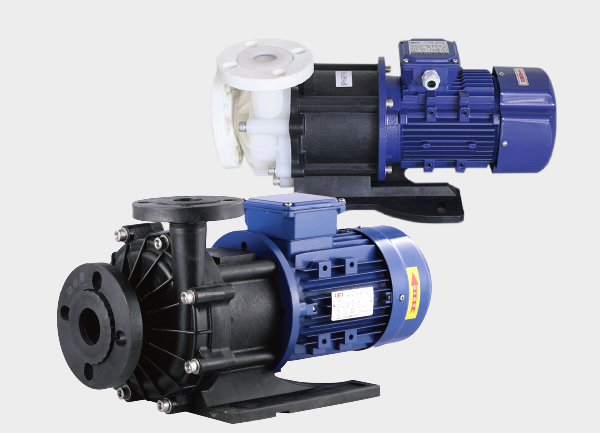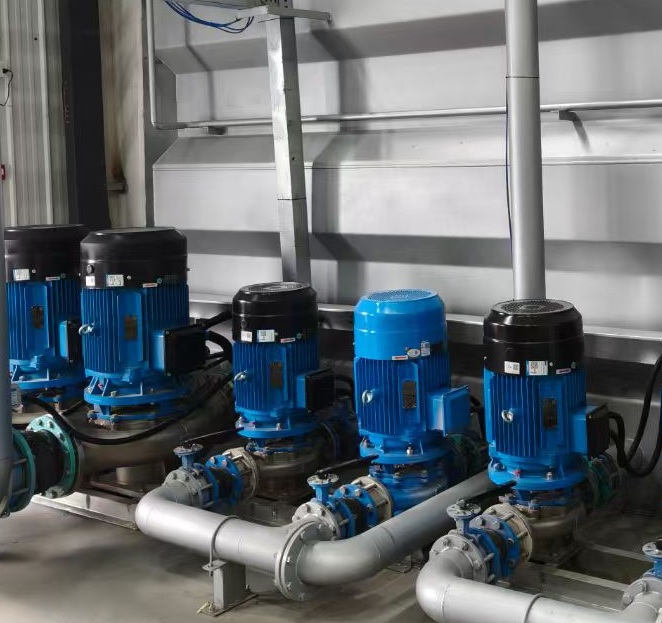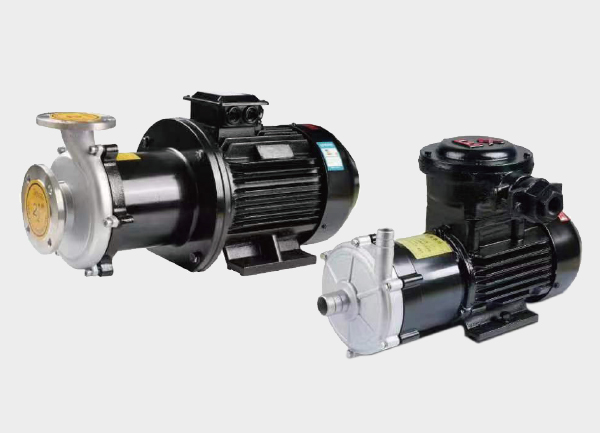
1. Working Principle: How Non-Contact Transmission Enables Zero Leakage
Stage 1: Power Input
Stage 2: Magnetic Field Penetration & Torque Transfer
- Transmission Efficiency: Typically 95% to 98%, slightly lower than the 98% to 99% efficiency of mechanical seal pumps. However, the zero-leakage benefit far outweighs this minor efficiency loss in high-risk applications.
Stage 3: Fluid Transfer
2. Key Components: Material & Structural Optimization for High Temperatures
| Component | Function | Material Selection (by Temperature Range) | Structural Optimization |
|---|---|---|---|
| Containment Shell | Isolates fluid from the outer magnetic rotor; withstands pump cavity pressure. | – Medium temp (≤200°C): 316L stainless steel, duplex steel 2205 – High temp (≤350°C): Hastelloy C276, Inconel 625 | 1. Thin-wall design (2–4mm) to reduce magnetic field loss 2. Polished inner wall (Ra ≤0.8μm) to minimize fluid erosion 3. Double-sided welding + non-destructive testing (NDT) to prevent cracking at high temps |
| Inner/Outer Magnetic Rotors | Transfer torque; generate rotating magnetic fields. | – Magnets: Samarium-cobalt (SmCo5/Sm2Co17), high-temp neodymium-iron-boron – Yoke (magnet holder): 1Cr18Ni9Ti, Hastelloy | 1. Alternating N-S pole arrangement for uniform magnetic fields 2. Full coating (e.g., PFA) to protect magnets from corrosive fluids 3. Dynamic balance grade G2.5 (higher than G6.3 for standard pumps) to reduce vibration |
| Bearings | Support the pump shaft; absorb radial/axial forces. | – Medium temp (≤200°C): Silicon nitride (Si₃N₄) ceramic bearings (corrosion-resistant, self-lubricating) – High temp (≤350°C): Graphite-impregnated metal bearings (e.g., copper-graphite) | 1. Self-lubrication using the transferred fluid (e.g., thermal oil, molten salt) 2. Thrust bearing design to prevent shaft axial movement at high temps |
| Cooling System | Controls temperatures of magnetic rotors, containment shell, and bearings. | – Cooling media: Circulating water, nitrogen, thermal oil – Structures: Jacket-type (around pump body/containment shell), internal cooling (hollow pump shaft) | 1. Temperature interlock: Auto-shutdown if cooling media flow is insufficient or temperature exceeds limits 2. Heat exchange efficiency design: Ensure containment shell temp ≤ fluid temp + 20°C to avoid cracking |
3. Performance Parameters: Critical Metrics for High-Temperature Operations
1. Rated Temperature (T)
- Standard models: 150°C–250°C (suitable for high-temperature water, thermal oil, low-viscosity chemicals).
- High-temperature models: 250°C–350°C (for molten salts, high-temperature organic acids, reactor discharge streams).
- Extreme-temperature custom models: 350°C–400°C (use Inconel 718 yokes and intermetallic compound bearings).
- Note: The rated temperature must be 20–30°C lower than the magnet’s maximum operating temperature to prevent demagnetization.
2. Flow Rate (Q) & Head (H)
- Flow range: 1–200 m³/h (smaller flows for labs/pharmaceuticals; larger flows for petrochemical plants).
- Head range: 10–150 m (multi-stage impellers are used for heads >100 m to avoid impeller strength issues at high temps).
- Best Efficiency Point (BEP): Select pumps where the required flow is 80%–120% of the BEP. Long-term operation at low flow causes fluid recirculation in the pump cavity, increasing temperature and accelerating magnet demagnetization.
3. Allowable Fluid Viscosity (μ)
- Standard models: ≤500 cSt (high viscosity increases torque demand, risking magnetic coupling slippage).
- High-viscosity models: Custom open-impeller designs + low-speed motors (e.g., 960 rpm) for μ=500–2,000 cSt (suitable for high-temperature resins or asphalt).
4. Solid Particle Tolerance
- Standard models: ≤0.1 mm particle size, ≤0.1% concentration (particles wear bearings and the containment shell, increasing leakage risk).
- Particle-resistant models: Equipped with 50–100 μm suction filters + wear-resistant ceramic bearings for ≤0.5 mm particles (e.g., high-temperature mineral slurries, catalyst slurries).
5. Rated Pressure (P)
- Casing pressure: 1.6–4.0 MPa (complies with ASME B73.3 or GB/T 13007 standards for high-temperature pressure ratings).
- Containment shell pressure: 1.2x the casing pressure (prevents shell rupture from internal/external pressure differences).
4. Selection Guide: Matching Pumps to Application Needs
Step 1: Analyze Fluid Properties (Top Priority)
- Corrosion: Choose wetted materials based on fluid pH and ion concentration (e.g., Hastelloy C276 for nitric acid, 316L for sulfuric acid, nickel alloys for strong alkalis).
- Vapor Pressure: High-temperature fluids (e.g., water at 200°C has a vapor pressure of 1.55 MPa) require sufficient Net Positive Suction Head (NPSH) to avoid cavitation. Cavitation damages the impeller and causes magnetic coupling slippage.
- Toxicity/Flammability: For toxic fluids (e.g., phosgene) or flammable fluids (e.g., high-temperature ethanol), use double containment shells (inner + outer) and install leakage detectors (e.g., hydrogen sensors, toxic gas sensors).
Step 2: Confirm Operating Conditions
- Temperature Matching: The pump’s rated temperature must exceed the fluid’s actual temperature by 10–20°C (a safety margin to prevent magnet demagnetization).
- Power Margin: Size the motor to 110%–120% of the pump’s rated shaft power. High temperatures increase fluid viscosity, raising shaft power and risking motor overload.
Step 3: Mitigate Key Risks
- Eddy Current Loss: Select containment shell materials with high electrical resistivity and low magnetic permeability (e.g., Hastelloy C276 has 3x the resistivity of 316L, reducing eddy current loss). Control shell thickness (too thick increases loss; too thin reduces pressure resistance).
- Cooling System: For fluids >200°C, use forced cooling (e.g., circulating water for the containment shell, nitrogen for the outer magnetic rotor) to prevent motor overheating (motor windings typically have a maximum temperature of 155°C).
5. Applications: Where HT-MDPs Excel
| Industry | Fluid Transferred | Operating Conditions (Temp/Pressure) | Core Requirements |
|---|---|---|---|
| Petrochemicals | High-temperature thermal oil (e.g., diphenyl ether, mineral oil), catalytic cracking slurry | 200–320°C / 1.6–2.5 MPa | Prevent thermal oil leakage (fire risk); resist wear from slurry particles |
| Fine Chemicals | High-temperature organic acids (e.g., adipic acid, benzoic acid), molten urea | 180–250°C / 1.0–1.6 MPa | Resist corrosion from organic acids; avoid urea crystallization and blockages |
| Pharmaceuticals | High-temperature drug solutions (e.g., antibiotic reaction mixtures), distillation bottom streams | 150–200°C / 0.8–1.2 MPa | Ensure sterility (zero leakage to prevent contamination); comply with GMP standards |
| New Energy | Molten salts (e.g., sodium nitrate-sodium nitrite mixtures), high-temperature electrolytes | 250–350°C / 2.0–4.0 MPa | Transfer heat transfer fluids for concentrated solar power (CSP) systems; ensure safety via zero leakage |
| Environmental Protection | High-temperature wastewater (e.g., incinerator flue gas scrubbing liquor), high-temperature sludge | 120–180°C / 1.2–1.8 MPa | Prevent wastewater leakage (environmental pollution); resist corrosion from acidic/alkaline fluids |
6. Maintenance Strategies: Extending Pump Lifespan
Routine Monitoring (Hourly Logs)
- Temperature: Track discharge temperature, cooling media temperature, and motor winding temperature (must stay ≤155°C).
- Vibration: Maintain vibration levels ≤4.5 mm/s (RMS). Excessive vibration indicates bearing wear or magnetic rotor imbalance.
- Leakage: Ensure no alarms from leakage detectors (for double containment shells, monitor pressure between inner and outer shells).
Scheduled Maintenance (By Operating Hours)
- 1,000 hours: Clean cooling water pipelines to remove scale and ensure sufficient flow.
- 3,000 hours: Replace bearings (ceramic bearings are prone to microcracks under long-term high temperatures).
- 8,000 hours: Test magnetic field strength with a gaussmeter. Replace magnetic rotors if strength drops by >10%.
- 12,000 hours: Disassemble the pump and inspect the containment shell’s inner wall. Replace the shell if wear depth exceeds 0.5 mm.
Troubleshooting Common Issues
- Magnetic Coupling Slippage: Caused by high fluid viscosity, low flow, or magnet demagnetization. Reduce viscosity, adjust flow, or replace rotors.
- Bearing Overheating: Caused by insufficient lubrication (low fluid flow) or worn bearings. Check suction lines for blockages or replace bearings.
- Containment Shell Rupture: Caused by excessive pressure differences or material fatigue. Inspect pressure control systems or replace the shell with a higher-pressure-rated model.



